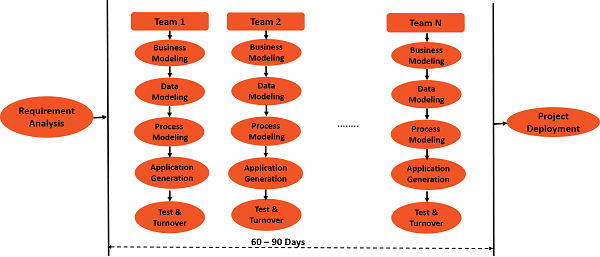
- Adaptive S/W Development Tutorial
- Adaptive S/W Development - Home
- Introduction
- SDLC Models - Evolution
- SDLC - Waterfall Model
- SDLC - Iterative Incremental Model
- Rapid Application Development
- SDLC - Spiral Model
- SDLC - Agile Methods
- Evolution
- Concepts
- Lifecycle
- Lifecycle Characteristics
- Practices
- Adaptive Management
- Useful Resources
- Quick Guide
- Useful Resources
- Discussion
SDLC - Rapid Application Development Model
Rapid Application Development (RAD) model has the following phases −
Requirements Planning phase − In the requirements planning phase, aworkshop needs to be conducted to discuss business problems in a structured manner.
User Description phase − In the User Description phase, automated tools are used to capture information from users.
Construction phase − In the Construction phase, productivity tools, such as code generators, screen generators, etc. are used inside a time-box, with a “Do until Done” approach.
Cut Over phase − In the Cut over phase, installation of the system, user acceptance testing and user training are performed.

Rapid Application Development Model – Strengths
The advantages or strengths of the Rapid Application Development model are as follows −
Reduced cycle time and improved productivity with fewer team members would mean lower costs.
Customer’s involvement throughout the complete cycle minimizes the risk of not achieving customer satisfaction and business value.
Focus moves to the code in a what-you-see-is-what-you-get mode (WYSIWYG). This brings clarity on what is being built is the right thing.
Uses modelling concepts to capture information about business, data, and processes.
Rapid Application Development Model – Weaknesses
The disadvantages or strengths of Rapid Application Development model are as follows −
Accelerated development process must give quick responses to the user.
Risk of never achieving closure.
Hard to use with legacy systems.
Developers and customers must be committed to rapid-fire activities in an abbreviated time frame.
When to Use Rapid Application Development Model?
Rapid Application Development model can be used when −
- User can be involved throughout the life cycle.
- Project can be time-boxed.
- Functionality can be delivered in increments.
Though the strengths of Rapid Application Development model are appreciated, it is sparingly used in the industry.
To Continue Learning Please Login